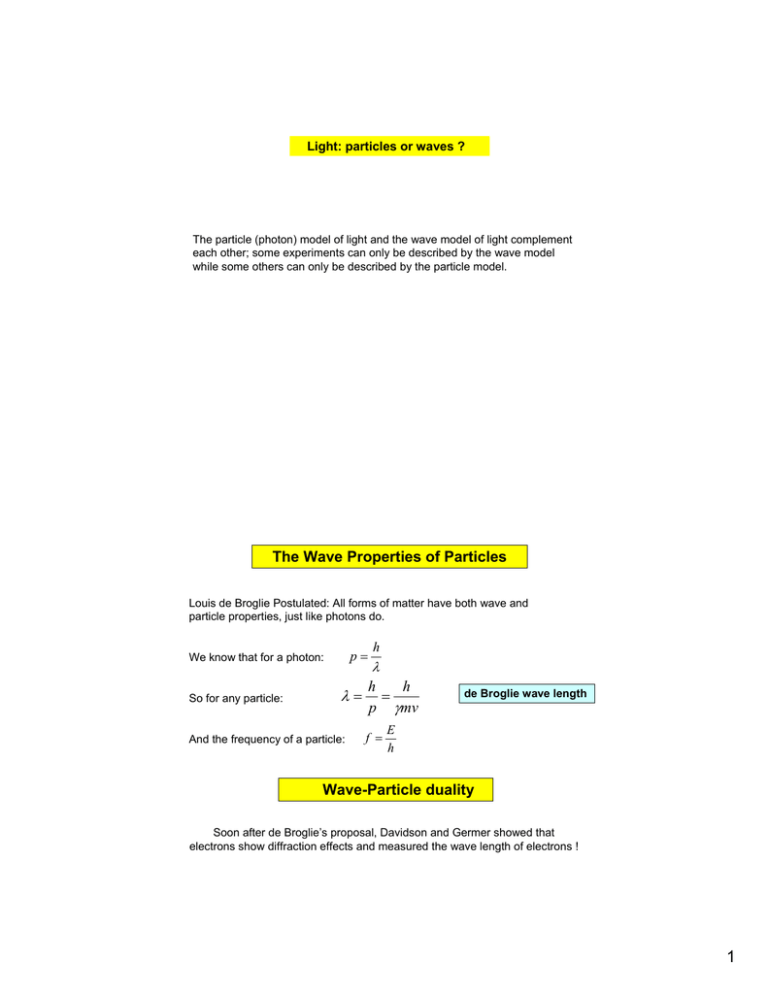1 γ λ - Galileo
advertisement

Light: particles or waves ? The particle (photon) model of light and the wave model of light complement each other; some experiments can only be described by the wave model while some others can only be described by the particle model. The Wave Properties of Particles Louis de Broglie Postulated: All forms of matter have both wave and particle properties, just like photons do. p= We know that for a photon: So for any particle: λ= And the frequency of a particle: h λ h h = p γmv f = de Broglie wave length E h Wave-Particle duality Soon after de Broglie’s proposal, Davidson and Germer showed that electrons show diffraction effects and measured the wave length of electrons ! 1 Double-Slit experiment with electrons d sin θ = λ 2 sin θ ≈ θ = h 2 pd 34. Calculate the de Broglie wavelength for an electron that has kinetic energy (a) 50.0 eV and (b) 50.0 keV. Are these electrons moving at relativistic velocities ? The rest energy of an electron = mec2 = 8.2 x 10-14 J = 8.2 x 10-14 / 1.6 x 10 -19 eV = 0.511 MeV So the total energy of the electron in the two given cases: (a) E= 511000 + 50 eV = 0.51105 MeV (b) E =511000 + 50000 eV = 0.551 MeV And γ for the two cases are: (a) γ= E = 1.0001 ER and (b) γ= E = 1.08 ER 2 34. Calculate the de Broglie wavelength for an electron that has kinetic energy (a) 50.0 eV and (b) 50.0 keV. p2 (a) = ( 50.0 ) 1.60 × 10 − 19 J 2m ( ) p = 3.81 × 10 − 24 k g ⋅ m h λ = = p (b) ( )(1.60 × 10 p = 1.20 × 10 − 22 k g ⋅ m The relativistic answer is slightly more precise: λ = About 200 times smaller than the wavelength of light 0.174 n m p2 = 50.0 × 10 3 2m λ = s − 19 ) J s h = 5.49 × 10 − 12 m p h hc = 1 p m c2 + K 2 − m 2 c4 . ( ) 2 = 5.37 × 10 − 12 m Electron Microscope About 100-200 times better resolution than an optical microscope 3 Bigger (and much more expensive) “Electron Microscope” pc = 6000 MeV λ= hc ≈ 7 × 10 −17 m pc E= ∞ 4 The Quantum Particle: Wave Packet An ideal particle would have zero size and would be localized in space An ideal wave has a single frequency and is infinitely long. Consider combining two waves with slightly different frequencies: When a large number of waves with varying frequencies are combined, there is destructive interference everywhere except near x=0 The result is a wave packet that is localized in space The quantum particle is a wave packet. 5 Uncertainty Principal Werner Heisenberg used quantum theoretical arguments so show that it is impossible to make simultaneous measurements of a particle’s position and momentum with infinite accuracy. This is known as the Heisenberg Uncertainty Principal If a measurement of the position of a particle is made with uncertainty ∆x and a simultaneous measurement of its x component of measurement made with uncertainty ∆px, the product is the two uncertainties can never be smaller than h/2 h 2 (h = h / 2π ) ∆x∆p x ≥ 6





